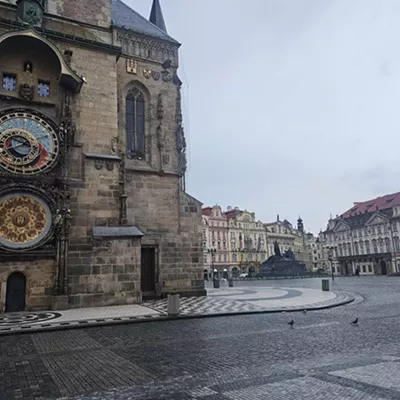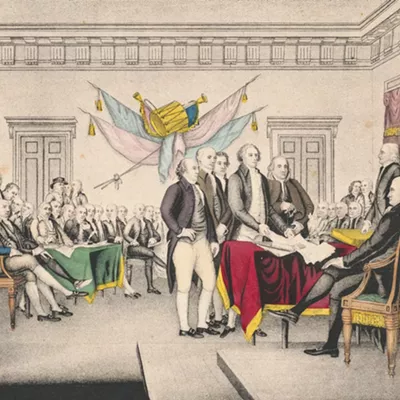Before the presidential election, the nation's capitol hosted its largest-ever gathering of First Nations people -- and it didn't have anything to do with George W. Bush or John Kerry. No, on Sept. 21, the new National Museum of the American Indian officially opened to the public.
All across the mall, the crowd celebrated unity in diversity. But what of the museum itself, 15 years and $219 million in the making? As is often the case with inherited property, the museum and the history it embodies have engendered darker and more divisive opinions among those it's meant to represent.
It is not lost on the Indian community that the government has found the money to create a showcase for the best of American Indian culture but has opposed programs to educate Indian children and to provide Indians with decent health care and housing. It has generally refused to offer any means of compensation for its historic devastation of the Native American way of life.
Clyde Bellecourt, who helped found the militant American Indian Movement in Minnesota in the late 1960s, came to Washington prepared to protest the offering of an official apology during the museum's opening ceremony. Drafted by Sens. Daniel Inouye and Ben Nighthorse Campbell, the "Resolution of Apology to Native People, S.J. Res. 37" ends with the disclaimer: "Nothing in this Joint Resolution authorizes any claim against the United States or serves as a settlement of any claim against the United States."
"This museum," Bellecourt said that day, "should be called The National Museum of the American Indian Holocaust.... Right now, over at the Mall of America, in Minnesota, where I live, they're digging up the bones of my ancestors." He was concerned that those who ignore the poverty still plaguing Native communities were singing those same communities' praises.
Sen. Campbell's politics, in particular, have earned him the nickname Ben "Nightmare" Campbell among some in the Indian community. In 1995, he switched his allegiance to the Republican Party because, he said, "I was tired of giveaway programs. And I think Indian tribes are a good example of people that have been almost forcefully made dependent on federal programs."
Bellecourt, on the other hand, wants to know how the Bureau of Land Management managed to misplace what he estimates to be some $200 billion owed to the American Indians to "lease" their lands, while the federal government files successive appeals against indigenous claims of broken treaties.
Just before the museum's opening, close to the Washington Mall, a much smaller group of Native Americans pitched tepees and participated in a less spectacular event, the 11th annual interfaith conference known as the Prayer Vigil for the Earth. At the vigil, prayers were offered to honor each of the four cardinal directions, a central concept shared by many indigenous spiritual traditions.
Those attending the vigil had prayers that were clearly not going to be answered by the NMAI. They prayed for the Kitigan Zibi Anishinabeg in Canada, where residents must drink bottled water because mining in the area has contaminated the groundwater with dangerous levels of uranium, and for the young people of the Pleasant Point reservation on the coast of Maine, subject to intense surveillance by numerous law enforcement agencies. Prayers were offered by a Din & eacute; woman who'd survived "boarding school" -- indoctrination camps, originally established by the War Department, where children were removed from their families and forced to cut their hair, learn English and adopt Christianity. And by a woman of the Acjachemen tribe of San Mateo, Calif., a group that had long ago built the San Juan Capistrano Mission. (During the mission's 2004 reopening ceremony, she "felt sick," she said, when she realized that the mission's committee weren't honoring the Acjachemen but rather the wealthy donors who'd financed the mission's reconstruction.)
Other misgivings about the museum centered on its appropriation of sacred materials. Grace Smith-Yellowhammer, a Din & eacute; elder, worries about the provenance of some of the estimated 800,000 objects in the museum's inventory. Many of the "artifacts" prized by curators are considered by religious practitioners to possess a spirit, a divine purpose and a sense of place, and they liken their placement in museums to imprisonment. In her sacred ceremonies, Jean Day, a Ho-Chunk activist and medicine woman, was entrusted by tribal elders with the use of a medicine pouch that she only recently discovered dated back to the 1600s.
Indeed, there are several sacred objects on display in the museum. In other respects, however, history is presented in emphatically non-materialist terms. From the wide windows that draw in the surrounding scenery, to the welcoming open space of its atrium, to its emphasis on crafts and contemporary artists, to its rippling architectural design and the cornstalks landscaping the site, the NMAI communicates a sense of life in flux.
W. Richard West, the museum's director, told the Washington Post that the tribulations of indigenous Americans account for "at best only about 5 percent of the period we have been in this hemisphere. We do not want to make the National Museum of the American Indian into an Indian Holocaust Museum." Thomas Sweeney, the museum's public affairs director, added that Native Americans "are not one homogenous group," and that the "Our Peoples" section of the museum acknowledges tragedy with its display of weapons, treaties, Bibles and other objects that illustrate centuries of oppression. He also said that an exhibit titled "Tribal Names, Past and Present," which commemorates vanished tribes, will soon be projected onto a wall using light, but was not ready in time for the opening.
On opening day, most of the participants were far more moved by the convergence of hundreds of tribes on the mall than they were by the museum itself -- they were there to honor First Nations people. Several groups wore buttons and T-shirts reading "Native Vote: Protecting Sovereignty." People regarded the museum as a starting point: an opportunity to educate one another, as well as the general public, about their cultures.
And everyone seemed to have brought an issue with them: The Penobscot River is being polluted by dioxin from paper mills; in Hawaii, people are being evicted from Mokuleia Beach to sanitize the scenery for television shows. The Wampanoag want official federal recognition. "Once people get a sense of the big picture," one Taino man suggested, "we can join forces."
And it already looks as though, despite the criticisms, the new museum will become a focal point for American Indian gatherings, from protests to powwows. Already, the National Powwow is planned to take place on the Washington Mall next September.
This article first appeared in The Nation.
Publication date: 11/18/04














